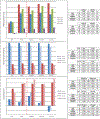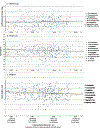Young adult outcomes in the follow-up of the multimodal treatment study of attention-deficit/hyperactivity disorder: symptom persistence, source discrepancy, and height suppression
- PMID: 28295312
- PMCID: PMC6168061
- DOI: 10.1111/jcpp.12684
Young adult outcomes in the follow-up of the multimodal treatment study of attention-deficit/hyperactivity disorder: symptom persistence, source discrepancy, and height suppression
Abstract
Background: The Multimodal Treatment Study (MTA) began as a 14-month randomized clinical trial of behavioral and pharmacological treatments of 579 children (7-10 years of age) diagnosed with attention-deficit/hyperactivity disorder (ADHD)-combined type. It transitioned into an observational long-term follow-up of 515 cases consented for continuation and 289 classmates (258 without ADHD) added as a local normative comparison group (LNCG), with assessments 2-16 years after baseline.
Methods: Primary (symptom severity) and secondary (adult height) outcomes in adulthood were specified. Treatment was monitored to age 18, and naturalistic subgroups were formed based on three patterns of long-term use of stimulant medication (Consistent, Inconsistent, and Negligible). For the follow-up, hypothesis-generating analyses were performed on outcomes in early adulthood (at 25 years of age). Planned comparisons were used to estimate ADHD-LNCG differences reflecting persistence of symptoms and naturalistic subgroup differences reflecting benefit (symptom reduction) and cost (height suppression) associated with extended use of medication.
Results: For ratings of symptom severity, the ADHD-LNCG comparison was statistically significant for the parent/self-report average (0.51 ± 0.04, p < .0001, d = 1.11), documenting symptom persistence, and for the parent/self-report difference (0.21 ± 0.04, p < .0001, d = .60), documenting source discrepancy, but the comparisons of naturalistic subgroups reflecting medication effects were not significant. For adult height, the ADHD group was 1.29 ± 0.55 cm shorter than the LNCG (p < .01, d = .21), and the comparisons of the naturalistic subgroups were significant: the treated group with the Consistent or Inconsistent pattern was 2.55 ± 0.73 cm shorter than the subgroup with the Negligible pattern (p < .0005, d = .42), and within the treated group, the subgroup with the Consistent pattern was 2.36 ± 1.13 cm shorter than the subgroup with the Inconsistent pattern (p < .04, d = .38).
Conclusions: In the MTA follow-up into adulthood, the ADHD group showed symptom persistence compared to local norms from the LNCG. Within naturalistic subgroups of ADHD cases, extended use of medication was associated with suppression of adult height but not with reduction of symptom severity.
Keywords: Attention-deficit/hyperactivity disorder; follow-up studies; growth; longitudinal studies; medication effects; treatment trials.
© 2017 Association for Child and Adolescent Mental Health.
Conflict of interest statement
Conflict of interest statement: See Acknowledgements for disclosures.
Figures


Similar articles
-
Trajectories of Growth Associated With Long-Term Stimulant Medication in the Multimodal Treatment Study of Attention-Deficit/Hyperactivity Disorder.J Am Acad Child Adolesc Psychiatry. 2020 Aug;59(8):978-989. doi: 10.1016/j.jaac.2019.06.019. Epub 2019 Aug 15. J Am Acad Child Adolesc Psychiatry. 2020. PMID: 31421233 Free PMC article.
-
Functional Adult Outcomes 16 Years After Childhood Diagnosis of Attention-Deficit/Hyperactivity Disorder: MTA Results.J Am Acad Child Adolesc Psychiatry. 2016 Nov;55(11):945-952.e2. doi: 10.1016/j.jaac.2016.07.774. Epub 2016 Sep 2. J Am Acad Child Adolesc Psychiatry. 2016. PMID: 27806862 Free PMC article.
-
National Institute of Mental Health Multimodal Treatment Study of ADHD follow-up: changes in effectiveness and growth after the end of treatment.Pediatrics. 2004 Apr;113(4):762-9. doi: 10.1542/peds.113.4.762. Pediatrics. 2004. PMID: 15060225 Clinical Trial.
-
Review: Adult Outcome as Seen Through Controlled Prospective Follow-up Studies of Children With Attention-Deficit/Hyperactivity Disorder Followed Into Adulthood.J Am Acad Child Adolesc Psychiatry. 2022 Mar;61(3):378-391. doi: 10.1016/j.jaac.2021.05.019. Epub 2021 Jun 8. J Am Acad Child Adolesc Psychiatry. 2022. PMID: 34116167 Review.
-
Effect of stimulants on final adult height.J Pediatr Endocrinol Metab. 2022 Oct 5;35(11):1337-1344. doi: 10.1515/jpem-2022-0344. Print 2022 Nov 25. J Pediatr Endocrinol Metab. 2022. PMID: 36193720 Free PMC article. Review.
Cited by
-
Mindfulness-Based Cognitive Therapy for Young People and Their Carers: a Mixed-Method Feasibility Study.Mindfulness (N Y). 2018;9(4):1063-1075. doi: 10.1007/s12671-017-0842-7. Epub 2017 Oct 27. Mindfulness (N Y). 2018. PMID: 30100931 Free PMC article.
-
Quantifying the Protective Effects of Stimulants on Functional Outcomes in Attention-Deficit/Hyperactivity Disorder: A Focus on Number Needed to Treat Statistic and Sex Effects.J Adolesc Health. 2019 Dec;65(6):784-789. doi: 10.1016/j.jadohealth.2019.05.015. Epub 2019 Jul 23. J Adolesc Health. 2019. PMID: 31350122 Free PMC article.
-
Home-based brain-computer interface attention training program for attention deficit hyperactivity disorder: a feasibility trial.Child Adolesc Psychiatry Ment Health. 2023 Jan 25;17(1):15. doi: 10.1186/s13034-022-00539-x. Child Adolesc Psychiatry Ment Health. 2023. PMID: 36698168 Free PMC article.
-
Neurofeedback versus psychostimulants in the treatment of children and adolescents with attention-deficit/hyperactivity disorder: a systematic review.Neuropsychiatr Dis Treat. 2018 Oct 30;14:2905-2913. doi: 10.2147/NDT.S178839. eCollection 2018. Neuropsychiatr Dis Treat. 2018. PMID: 30464474 Free PMC article. Review.
-
Change in Striatal Functional Connectivity Networks Across Two Years Due to Stimulant Exposure in Childhood ADHD: Results from the ABCD Sample.medRxiv [Preprint]. 2024 Jun 18:2024.03.18.24304470. doi: 10.1101/2024.03.18.24304470. medRxiv. 2024. Update in: Transl Psychiatry. 2024 Nov 6;14(1):463. doi: 10.1038/s41398-024-03165-7. PMID: 38562872 Free PMC article. Updated. Preprint.
References
-
- American Academy of Pediatrics, Subcommittee on Attention-Deficit/Hyperactivity Disorder, Steering Committee on Quality Improvement and Management. Pediatrics. 2011; 128: 1–14. - PubMed
-
- Barkley R, Murphy K, Fischer M. ADHD in Adults: What Science Says. NY: Guilford; 2008.
-
- Biederman J, Monuteaux MC, Spencer T, et al. Stimulant therapy and risk for subsequent substance use disorders in male adults with ADHD: A naturalistic controlled 10-year follow-up study. Am J Psychiatry. 2008; 165: 597–603. - PubMed
Publication types
MeSH terms
Grants and funding
- U01 MH050467/MH/NIMH NIH HHS/United States
- N01 MH012008/MH/NIMH NIH HHS/United States
- U01 MH050461/MH/NIMH NIH HHS/United States
- HHSN271200800008C/DA/NIDA NIH HHS/United States
- U01 MH050440/MH/NIMH NIH HHS/United States
- N01 DA085550/DA/NIDA NIH HHS/United States
- N01 DA085548/DA/NIDA NIH HHS/United States
- N01 MH012012/MH/NIMH NIH HHS/United States
- HHSN271200800003C/DA/NIDA NIH HHS/United States
- N01 DA085549/DA/NIDA NIH HHS/United States
- N01 MH012010/MH/NIMH NIH HHS/United States
- HHSN271200800009C/DA/NIDA NIH HHS/United States
- HHSN271200800005C/DA/NIDA NIH HHS/United States
- U54 HD090257/HD/NICHD NIH HHS/United States
- HHSN271200800006C/DA/NIDA NIH HHS/United States
- N01 DA085553/DA/NIDA NIH HHS/United States
- N01 MH012011/MH/NIMH NIH HHS/United States
- K23 DA032577/DA/NIDA NIH HHS/United States
- N01 MH012004/MH/NIMH NIH HHS/United States
- N01 DA085554/DA/NIDA NIH HHS/United States
- N01 MH012009/MH/NIMH NIH HHS/United States
- U01 MH050453/MH/NIMH NIH HHS/United States
- N01 MH012007/MH/NIMH NIH HHS/United States
- N01 DA085551/DA/NIDA NIH HHS/United States
- HHSN271200800007C/DA/NIDA NIH HHS/United States
- R01 DA039881/DA/NIDA NIH HHS/United States
LinkOut - more resources
Full Text Sources
Other Literature Sources
Medical

